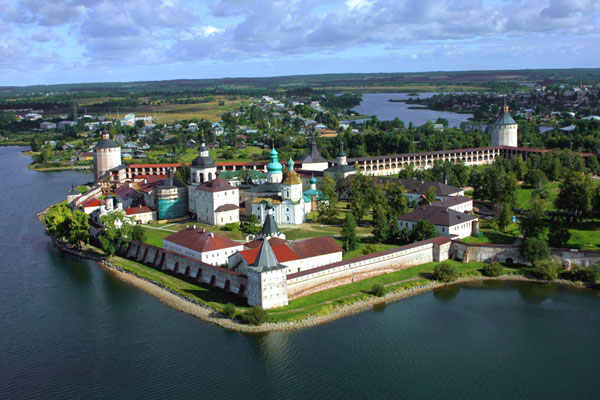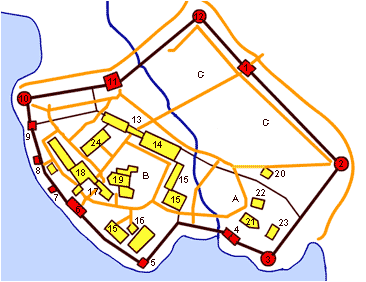

Location: Belozersk, Vologda Oblast Map
Established: 1397
The Kirillo-Belozersky Monastery, also known as the St. Cyril-Belozersky Monastery, is a historic Russian Orthodox monastery located on the shores of Lake Siverskoye in the town of Kirillov, within the Vologda Oblast of northern Russia. Founded in 1397, it stands as one of the largest and most significant monastic complexes in Europe, often compared to a fortress due to its imposing walls and towers. The monastery was dedicated to the Dormition of the Theotokos (the Virgin Mary) and played a pivotal role in the spiritual and cultural life of the Russian North during the 15th to 17th centuries, becoming one of the wealthiest and most influential religious centers in Russia. Today, much of it functions as the Kirillo-Belozersky Museum of History, Art, and Architecture, while a smaller section remains an active monastic community.
 1.
Kazan Tower with main entrance gate
1.
Kazan Tower with main entrance gate
2. Vologda Tower
3.
Kuznechnaya aka Blacksmith Tower
4. Gluchaya Tower aka Blind End
Tower
5. Svitochnaya Tower
6. Vodyanaya Tower aka Water Tower
with Church of Transfiguration
7. Chlebnaya Tower aka Bread Tower
8. Povarennaya Tower aka Cook Tower
9. Malaya Merezhennaya Tower
10. Belozerskaya Tower
11. Kosaya Tower
12. Feropont Tower
13. Holy Gate with a church of Saint John Lestvichnik and Treasury
14. Monks quarters- Northern Wing
15. Monks quarters- South Wing
16. Church of Saint Euphimia and a hospital
17. Bell Church of
Archangel Gabriel
18. Dining Hall and a kitchen
19. Uspensky
Cathedral and a Church of Saint Vladimir, Cyril and Epiphany
20.
Church of Rizopolozheniya
21. Church of Saint Sergius of Radonezh
with dining hall
22. Church of John the Baptist
23. Small
Hospital quarters
24. Igumen (head of the monastery) quarters
A. Ivanovsky Monastery
B. Uspensky Monastery
C. New City
The monastery's origins trace back to St. Kirill (Cyril) of
Beloozero, a monk from the Simonov Monastery in Moscow, who sought
solitude following the guidance of his mentor, St. Sergius of
Radonezh. In the summer of 1397, Kirill, along with fellow monk
Ferapont, arrived at the site and initially dug a cave for shelter
before constructing the first wooden structures. Ferapont soon
departed in 1398 to establish the nearby Ferapontov Monastery, about
20 km away, leaving Kirill to develop the site further. The
location, near the former town of Beloozero (now Belozersk), was
strategically chosen for its isolation, yet it quickly grew due to
donations from nobility and pilgrims.
By the 15th century, the
monastery had expanded significantly, attracting monks and becoming
a spiritual hub. In the 16th century, it reached its zenith as the
second-richest landowner in Russia, with close ties to the ruling
elite, including Tsar Ivan the Terrible, who visited three times (in
1545, 1553, and 1569) and contributed generously. The monastery's
wealth stemmed from vast land holdings, trade privileges, and salt
production in the region. It served as a refuge for nobility and a
center for manuscript copying, icon painting, and education.
The
17th century brought challenges, including invasions. The massive
fortifications were erected between 1654 and 1680 to defend against
Lithuanian and Polish forces during the Time of Troubles and
subsequent conflicts. Despite these defenses, the monastery could
not withstand the Bolshevik Revolution; in 1924, it was closed, its
monks executed or exiled, and the complex was repurposed as a
museum-reserve. Unlike many others, it avoided conversion into a
concentration camp. In 1997, it was designated a cultural heritage
site of federal significance in Russia, and by 1998, a small priory
(the Ivanovsky Monastery within the complex) was reopened for
monastic life. As of 2011, it was one of only four active
monasteries in Vologda Oblast, with a handful of monks residing
there. The nearby Ferapontov Monastery, part of the same historical
ensemble, features frescoes by the renowned icon painter Dionysius
and was added to UNESCO's World Heritage List in 2000.
The Kirillo-Belozersky Monastery is renowned for its fortress-like
architecture, blending monastic simplicity with defensive grandeur. The
complex spans a vast area, divided into two main sections: the larger
Assumption Monastery (Uspensky) and the smaller Ivanovsky Monastery. Its
kremlin-style walls, stretching about 0.8 km (half a mile) in length,
are up to 7 meters (23 feet) thick and fortified with 10 towers, giving
it the appearance of a medieval castle rather than a purely religious
site. These walls, constructed in brick and stone, feature loopholes for
defense and were designed to withstand sieges.
At the heart of the
complex is the Cathedral of the Assumption (Uspensky Sobor), built
between 1497 and 1498, which serves as the main church. This structure
exemplifies late 15th-century Russian architecture with its whitewashed
walls, multiple domes, and intricate frescoes. Adjacent are 11 other
churches, mostly from the 16th century, including the Church of the
Transfiguration over the Gate (1595), the Church of St. John Climacus
(1572), and the Church of the Archangel Gabriel (1534). The ensemble
also includes refectories, bell towers, and monastic cells, many adorned
with ornamental sewing, icons, and manuscripts from the museum's
collections.
Notable features include the Holy Gates with their
ornate entrances, the Hospital Church of St. Euthymius (1640s), and the
Water Gates leading to the lake. The monastery's design reflects
influences from Moscow and Novgorod architectural schools, with elements
like zakomary (semicircular gables) and kokoshniki (tiered decorative
arches). Outside the main walls stands the Cathedral of the Icon of Our
Lady of Kazan (1823), a later addition in neoclassical style. The
overall layout, with its enclosed courtyards and interconnected
buildings, creates a self-contained world, symbolizing monastic
seclusion amid the northern wilderness.
As a spiritual center, the monastery was instrumental in the spread
of Orthodox Christianity in Russia's northern territories, producing
influential saints and scholars. Its scriptorium preserved ancient
manuscripts, and its art collections include rare icons, embroidered
vestments, and folk art artifacts. The site has witnessed key historical
events, from royal pilgrimages to revolutionary upheavals, embodying
Russia's turbulent past.
In modern times, it attracts tourists for
its architectural beauty and serene lakeside setting, often described as
a "pearl of the Russian North." The museum hosts exhibitions on Russian
history, art, and archaeology, while the active monastic community
maintains traditions of prayer and hospitality. Its inclusion in
Russia's cultural heritage list underscores its enduring value as a
testament to medieval Russian engineering, faith, and resilience.